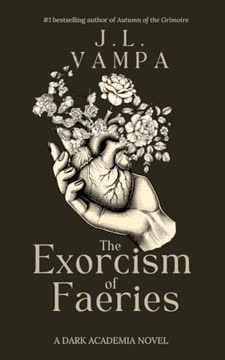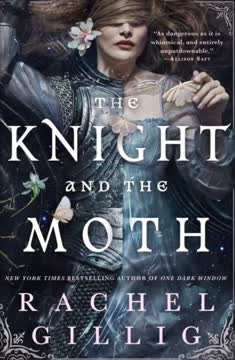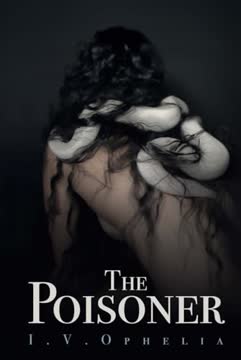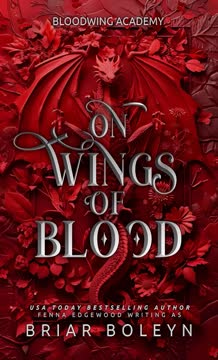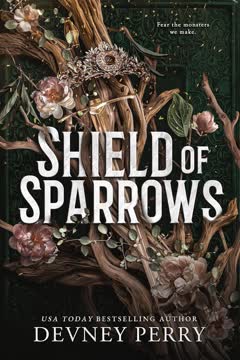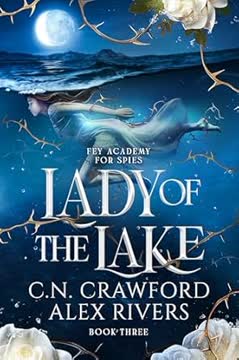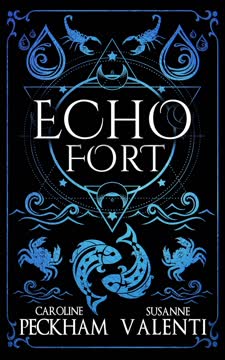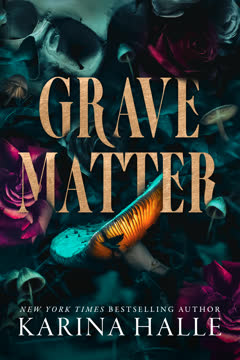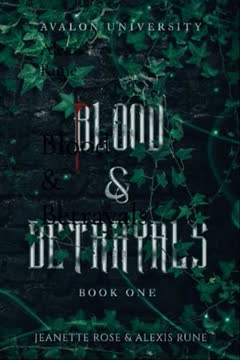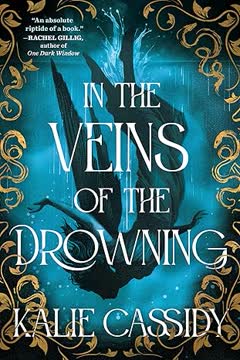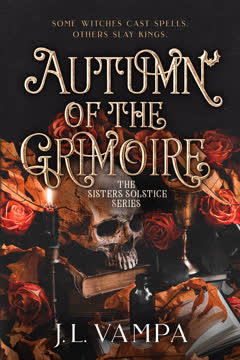Plot Summary
Corpse in the Rain
Ariatne "Atta" Morrow, a postgraduate student and part-time morgue worker, struggles to move a corpse in the rain, her actions shrouded in secrecy. She's no stranger to death, but this body is different—its lungs contain a strange, otherworldly bloom. Driven by curiosity and desperation, Atta risks everything to investigate, setting the stage for her entanglement with the mysterious Achilles House, a secretive society at Trinity College. The rain, the corpse, and the clandestine delivery all foreshadow the collision of science and folklore that will define her journey. Atta's determination and wit shine through, even as the darkness of the Plague and her own haunted past begin to close in.
Secret Societies and Masks
Atta's delivery of the corpse to Achilles House introduces her to a world of masked anatomists, each identified by colored stitches on their plague doctor masks. The enigmatic Gold Stitch, later revealed as Dr. Sonder Murdoch, challenges her, both intellectually and morally. Their terse exchange over payment and the rules of corpse procurement sets up a tense, transactional relationship. The secret society's hierarchy and rituals are both alluring and menacing, hinting at deeper secrets. Atta's cleverness and stubbornness earn her a place in their dangerous game, while the Plague's mysteries—and the society's true motives—begin to unravel.
The Plague's Strange Bloom
Atta's autopsy reveals a macabre flower growing from the corpse's lungs, a phenomenon unseen in any medical text. This "bloom" is not just a symptom but a sign of something unnatural infecting the dead. The Plague, once thought to be a disease, now appears to be something far stranger—an invasion of flora, perhaps even faerie in origin. Atta's scientific curiosity is piqued, but so is her fear. The boundaries between science and folklore blur, and her visions intensify. The bloom becomes a symbol of the Plague's true nature and the key to understanding the threat facing Dublin.
Academic Struggles and Alliances
Atta's life at Trinity is fraught with challenges: denied funding, overworked, and forced to take a TA position with the intimidating Dr. Murdoch. Her relationships with roommates and colleagues are strained by the pressures of the Plague and her own obsessions. Yet, alliances form—Emmy, Gibbs, and others become unlikely friends and confidants. Atta's resilience is tested as she juggles her studies, morgue work, and secret dealings with Achilles House. The academic setting, with its rituals and hierarchies, mirrors the secret societies lurking beneath, and Atta's place in both worlds grows ever more precarious.
The Gold-Stitch Bargain
The transactional relationship between Atta and Sonder deepens as they strike a bargain: she supplies corpses with signs of the Plague's flora, and he provides her with tools and access. Their interactions are fraught with tension, attraction, and mutual suspicion. Sonder's own motives are ambiguous—he seeks a cure, but his methods are secretive and sometimes ruthless. The bargain binds them together, forcing both to confront their own ethical boundaries. As the Plague's supernatural nature becomes clearer, their partnership evolves from mere convenience to a shared quest for answers—and survival.
Visions and Hallucinations
Atta is plagued by migraines and vivid hallucinations—visions of faerie woods, creeping vines, and spectral women. These episodes, initially dismissed as stress or illness, soon reveal themselves as glimpses into the true nature of the Plague. Atta's connection to the supernatural deepens, blurring the line between reality and myth. Her visions become both a curse and a guide, leading her toward the heart of the mystery. The pain and fear they bring are matched only by the insights they offer, as Atta realizes she may be the key to stopping the faerie invasion.
The Anatomy of Death
Atta and Sonder's investigations uncover more bodies with signs of faerie flora—blackened veins, strange fungi, and otherworldly growths. Their scientific approach is challenged by the inexplicable, as each autopsy brings them closer to the truth: the Plague is not a disease, but a possession. The dead and dying are being used as vessels for something ancient and malevolent. The anatomy of death becomes a battleground between science and magic, and Atta's skills as both botanist and mortician are put to the ultimate test.
The Flora Within
The pattern of infection—flora sprouting from organs, black blood, and the presence of coins marked with hawthorn—points to a faerie origin. Atta and Sonder theorize that the Plague is a form of faerie possession, using humans as soil for their own world's survival. The hawthorn, a symbol of faerie magic, becomes central to their research. The realization that the Plague is a supernatural invasion, not a natural disease, changes everything. The stakes are raised: this is not just a medical crisis, but a war between worlds.
The Exorcism Pact
Drawing on folklore, botany, and anatomy, Atta and Sonder devise a protocol for exorcising the faerie spirits from the infected. Their methods—smudge sticks, black salt, iron, and sacred rituals—blend science and magic. The exorcisms are harrowing, often deadly, but increasingly successful. As word spreads, they become Dublin's masked healers, sought after by the desperate. Their partnership deepens into love, even as the dangers mount. The exorcism pact is both a scientific breakthrough and a spiritual battle, with Atta at its heart.
The Faerie Possession
The Plague's victims are revealed to be "Inhabited," not merely infected. The faerie spirits seek pairs—one to serve as soil, another as nourishment. Atta's visions intensify, showing her the faerie world and its dying forests. The boundary between the living and the dead, the human and the faerie, grows thin. The exorcisms become a race against time, as the faeries adapt and grow stronger. Atta's own connection to the faerie realm deepens, making her both a target and a weapon in the fight to save Dublin.
The Hawthorn Grove Secret
Atta's visions and research lead her to the Hawthorn Grove at Murdoch Manor, where Sonder's mother, Olivia, unwittingly opened a portal to the faerie world. The grove, the site of Olivia's burial, is the epicenter of the invasion. Atta discovers a lost book of fairytales, Into the Faerie Wood, and realizes that Olivia's actions—and Sonder's burial of his parents under the wrong tree—delayed the faerie conquest. The secret of the grove is both a curse and a hope: it holds the key to closing the portal and ending the Plague.
The Society's Ultimatum
The secret society, Agamemnon, led by Lynch and Rochford, demands that Atta and Sonder reveal their methods and pledge loyalty in exchange for protection and academic reinstatement. The council's true motives are political, seeking glory and control. Atta refuses to be their pawn, choosing instead to continue the fight on her own terms. The society's ultimatum raises the stakes, forcing Atta and Sonder to choose between safety and integrity. Their defiance marks them as outcasts, but also as true heroes.
The Portal and the Sacrifice
As the faerie possession spreads and the wards fail, Atta realizes she must sacrifice herself to close the portal. Guided by visions and Olivia's spirit, she enters the Hawthorn Grove, drinks Sonder's embalming fluid, and performs a final exorcism on herself. The act destroys the portal, collapses the manor, and ends the faerie invasion—but nearly kills her. Sonder's grief and love bring her back, and together they emerge from the ruins, battered but victorious. The sacrifice is both tragic and redemptive, sealing the door between worlds.
The End of the Plague
With the portal closed and the faerie spirits banished, the Plague ends. Survivors emerge from the wreckage, scarred but alive. The city is saved, but the cost is high—lives lost, secrets revealed, and the world forever changed. Atta and Sonder's love endures, forged in the crucible of tragedy and triumph. The supernatural and the scientific have merged, leaving a legacy of wonder and warning. The end of the Plague is both an ending and a beginning, as Dublin heals and remembers.
Aftermath and New Beginnings
In the aftermath, Atta is reinstated at Trinity, now a professor teaching the history of the Fae Plague. She and Sonder, partners in love and science, build a new life together, their bond unbreakable. The world knows their story, but only they know the true cost. The lessons of the Plague—about the dangers of hubris, the power of love, and the thin veil between worlds—linger. The story ends with hope, as Atta welcomes a new generation of students, ready to face whatever mysteries the future may hold.
Characters
Ariatne "Atta" Morrow
Atta is a fiercely intelligent, stubborn, and compassionate postgraduate student of botany and folklore, working in a Dublin morgue during the Plague. Raised among the dead, she is both comfortable with death and driven by a need to understand it. Her scientific mind is matched by a deep connection to the supernatural, manifesting in migraines and visions that reveal the Plague's true faerie nature. Atta's relationships—with Sonder, her friends, and her academic world—are shaped by her outsider status and her refusal to accept easy answers. Over the course of the story, she evolves from a desperate, isolated researcher to a leader and savior, willing to sacrifice herself to save others. Her journey is marked by resilience, vulnerability, and a growing acceptance of her own power.
Dr. Sonder Murdoch
Sonder is a brilliant, brooding professor of morbid anatomy at Trinity and the enigmatic Gold Stitch of Achilles House. Scarred by the loss of his parents to the Plague, he is driven by a relentless quest for answers and a deep sense of responsibility. His intellect is matched by a capacity for tenderness, especially in his relationship with Atta. Sonder's role as both scientist and secret society leader places him at the center of the conflict between science, magic, and politics. His development is shaped by his willingness to challenge authority, his growing vulnerability with Atta, and his ultimate acceptance of love and partnership as sources of strength rather than weakness.
Emmy Quinn
Emmy is Atta's fellow TA and eventual confidante, providing warmth, humor, and practical support. Her initial skepticism gives way to belief as she witnesses the supernatural firsthand. Emmy's role as a bridge between the academic and personal worlds is crucial, grounding Atta and helping to build the team needed to fight the Plague. Her own struggles with belonging and purpose mirror Atta's, and her loyalty is unwavering.
Bernard "Gibbs" Fitzgibbon
Gibbs is a gangly, well-meaning assistant at Achilles House and a member of Agamemnon. His anxiety and awkwardness mask a deep loyalty and surprising courage. Gibbs's role as an informant and organizer is vital, and his friendship with Atta and Emmy provides comic relief and emotional support. His own moral dilemmas—caught between loyalty to the Society and to his friends—reflect the larger conflicts of the story.
Imogen
Imogen is Atta's hard-partying, skeptical roommate, initially dismissive of the Plague's dangers. Her eventual possession by the faerie spirits brings the threat home, forcing Atta and the others to confront the personal cost of their battle. Imogen's arc—from denial to victimhood to survival—mirrors the city's journey through the crisis.
Professor Marguerite Vasilios
Marguerite is a respected professor and member of Agamemnon, drawn into the fight by her connection to Sonder and her own sense of duty. Her expertise in mental health and her willingness to challenge the Society's authority make her a key ally. Marguerite's pragmatism and empathy help balance the team, and her own history with Sonder adds depth to their dynamic.
Dean Finneas Lynch
Lynch is the dean of Trinity and a high-ranking member of Agamemnon, obsessed with control and reputation. His willingness to sacrifice individuals for the Society's glory makes him a formidable adversary. Lynch's manipulations and ultimatums drive much of the external conflict, forcing Atta and Sonder to choose between safety and integrity.
Olivia Murdoch
Sonder's mother, Olivia, is the unwitting origin of the Plague, having opened a portal to the faerie world through her own longing and magic. Her death and burial under the wrong hawthorn tree delay the faerie invasion, making her both a victim and a savior. Olivia's presence haunts both Sonder and Atta, guiding them through visions and memories toward the final sacrifice.
The Faerie Spirits
The faerie spirits are the true antagonists, seeking to possess humans and transform the world into a new home as their own realm dies. Their methods—possession, flora, and manipulation—are both terrifying and tragic. The faeries' motivations, revealed through Atta's visions, add complexity to the conflict, making them more than mere monsters.
The Agamemnon Council
The council, led by Rochford and Lynch, represents the entrenched power structures of Trinity and Dublin. Their obsession with control, secrecy, and glory puts them at odds with Atta and Sonder's more humane, open approach. The council's machinations drive much of the story's tension, forcing the protagonists to navigate a web of alliances and betrayals.
Plot Devices
Science and Folklore Intertwined
The novel's central device is the fusion of scientific investigation and folklore, embodied in Atta's dual expertise and Sonder's anatomical rigor. Autopsies, botanical research, and academic rituals are juxtaposed with faerie lore, visions, and magical rituals. This interplay allows the story to explore the limits of knowledge, the power of belief, and the necessity of embracing both reason and wonder to confront the unknown.
Masked Identity and Secret Societies
The use of plague doctor masks and secret societies creates an atmosphere of mystery and danger. The masks symbolize both protection and deception, while the societies' rituals and hierarchies mirror the academic world's own structures. The tension between public and private, seen and unseen, drives much of the plot, as characters navigate shifting allegiances and hidden motives.
Visions and Synesthesia
Atta's migraines and visions serve as both a curse and a guide, providing glimpses into the faerie world and the true nature of the Plague. These episodes blur the line between reality and myth, science and magic, and force Atta to accept her own role as a medium between worlds. The visions also serve as foreshadowing, revealing key plot points and emotional truths before they are fully understood.
The Hawthorn Grove and the Portal
The Hawthorn Grove at Murdoch Manor is both the literal site of the faerie invasion and a symbol of the boundary between worlds. Its significance is revealed gradually, through research, visions, and personal history. The grove's role as both curse and hope—origin and solution—anchors the story's climax and resolution.
The Exorcism Protocol
The development of the exorcism protocol—combining smudge sticks, black salt, iron, and embalming fluid—embodies the novel's central theme of synthesis. The protocol is both a scientific breakthrough and a magical ritual, requiring teamwork, courage, and faith. Its evolution mirrors the characters' own growth and the merging of their disparate worlds.
Sacrifice and Redemption
The story's emotional arc is driven by sacrifice—Atta's willingness to risk her life, Sonder's vulnerability, and the loss of loved ones. The final act, in which Atta exorcises herself and closes the portal, is both tragic and redemptive, fulfilling the story's promise that true change requires both suffering and hope.
Analysis
The Exorcism of Faeries is a rich, genre-blending novel that uses the trappings of gothic horror, academic intrigue, and supernatural romance to explore timeless questions: What happens when the rational world collides with the mythic? How do we confront the unknown—through science, faith, or both? The story's Dublin setting, with its rain-soaked streets, ancient colleges, and secret societies, provides a perfect backdrop for a tale of possession, sacrifice, and redemption. Atta and Sonder's journey—from adversaries to partners, from skeptics to believers—mirrors the reader's own confrontation with mystery and mortality. The novel's central lesson is that true understanding requires humility, courage, and the willingness to embrace both the seen and unseen. In a world beset by invisible threats—be they plagues, powers, or prejudices—The Exorcism of Faeries offers a vision of hope: that love, knowledge, and sacrifice can close even the darkest of doors.
Last updated:
Review Summary
The Exorcism of Faeries received mixed reviews, with an average rating of 3.94 out of 5. Many readers praised its gothic atmosphere, dark academia setting, and unique blend of Irish folklore and fantasy. The romance between the main characters, Atta and Sonder, was well-received by some but criticized as underdeveloped by others. While the book's premise and world-building were generally appreciated, some readers found the pacing inconsistent and the ending rushed. Overall, the book appealed to fans of gothic romance and dark fantasy, though it didn't meet everyone's expectations.
Morbid Realities Series
Similar Books
Download PDF
Download EPUB
.epub digital book format is ideal for reading ebooks on phones, tablets, and e-readers.
